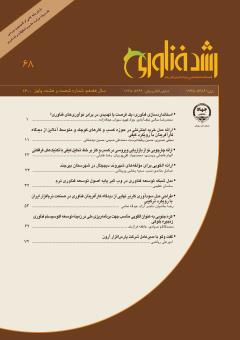مدل شبکه توسعه فناوری در وب 5 بر پایه اصول توسعه فناوری نرم
محورهای موضوعی : مديريت تحقيق و توسعه
1 - دانشگاه تهران
کلید واژه: فنکاوی, شبکه توسعه فناوری, وب 5, گراف ارتباط فناوریها, زبان توسعه فناوری,
چکیده مقاله :
زبان و خط از عوامل مهم پیشرفت بشر در طول تاریخ بودهاند [1]. با افزایش استفاده کنندگان از یک زبان یا خط جدید، مجموعه تعاملی بزرگتری از انسانها شکل گرفته و تعامل بیشتر، سنجههای فردی و اجتماعی پایه همچون فرهنگ، سطح فکر، شعور اجتماعی و علم و دانش را رشد داده است. چنین روندی در طول تاریخ بارها تکرار شده و دگرگونی جوامع بشری را به دنبال داشته است. در قرن اخیر چنین دگرگونیهایی افزایش یافته و قلههای بسامد تکامل به هم نزدیکتر شدهاند. اما در صدسال گذشته این دگرگونیها به دلیل اختراع زبان یا خط طبیعی حادث نمیشوند بلکه این زبانها و پروتکلهای جدید دنیای فناوری اطلاعات و ارتباطات هستند که قلههای دگرگونی را شکل میدهند. طی سالهای اخیر، پدیدههای جدیدی به دنیا اضافه شدهاند که سنت دگرگونی توسعه برای آنها نیز در حال تکرار است که یکی از بارزترین و گستردهترین نمونههای آن، اینترنت است. پدیده اینترنت زمانی شکل میگیرد که رایانهها یاد میگیرند با یک زبان مشترک با یکدیگر سخن بگویند. تشویق به افزایش این نوع تعاملها گاهی کاملا مستقیم مطرح شده و تلاش چندانی برای ارائه زیرساخت نمیشود. مواردی همچون نوآوری باز یا مدیریت دانش، در سالهای اخیر با شعار به اشتراک گذاری پدیدههایی از جنس دانش، شکل گرفته و در مقیاس سازمانی تا جهانی، موثر بودهاند. در مواردی هم تلاش برای ایجاد زیر ساختی صورت گرفته است که در نهایت سطح تعاملات را بالا برده
A couple of technologies are growing extraordinarily and pervasive much faster and more widely than usual. Investigate their trend of development shows that their growth path is not only linear, but these technologies, years after their invention and birth, have a little story and limited success, but suddenly jump and advance on a global scale. Examining the main reasons and bases of this growth shows that there are general rules in development while applying in the case of technology, lead to rapid development. This paper briefly discusses such technologies. The generations Web as a comprehensive and close case to the subject of this article - the network of technology development - are discussed. Understanding the pillar foundations of this launchpad and modeling it for the technology development network, provides the infrastructure for systematic acceleration in technology development. In this paper, the definition of each of these basic concepts is presented in accordance with the technology development network, and the implementation manner is mentioned.
[1] A. Robinson, Writing and script: a very short introduction, vol. 208. Oxford University Press, 2009.
[2] H. Intven, Telecommunications regulation handbook. Washington, DC: World Bank, 2000.
[3] N. Choudhury, “World wide web and its journey from web 1.0 to web 4.0,” Int. J. Comput. Sci. Inf. Technol., vol. 5, no. 6, pp. 8096–8100, 2014.
[4] Zhaoyu Liu, A. W. Joy, and R. A. Thompson, “A dynamic trust model for mobile ad hoc networks,” in Proceedings. 10th IEEE International Workshop on Future Trends of Distributed Computing Systems, 2004. FTDCS 2004., 2004, pp. 80–85, doi: 10.1109/FTDCS.2004.1316597.
[5] Y. Wang and J. Vassileva, “Bayesian network-based trust model,” in Proceedings IEEE/WIC International Conference on Web Intelligence (WI 2003), 2003, pp. 372–378, doi: 10.1109/WI.2003.1241218.
[6] Y. Zhang, H. Chen, and Z. Wu, “A social network-based trust model for the semantic web,” in International Conference on Autonomic and Trusted Computing, 2006, pp. 183–192.
[7] D. Price, “Alibaba overtakes Facebook as world’s sixth-most valuable company after shares soar by 10 per cent in Hong Kong.” [Online]. Available: https://www.scmp.com/business/money/stock-talk/article/3092502/alibaba-overtakes-facebook-worlds-sixth-most-valuable.
[8] A. L. Porter, “Tech mining for future-oriented technology analyses,” Futur. Res. Methodol., 2009.
[9] A. Schoen et al., “The network structure of technological developments; Technological distance as a walk on the
technology map,” in Science & Technology Indicators (STI) Conference, 2012. [10] G. M. Garland and others, “Technology Forecasting (TF) using Hybrid Tech Mining, TRIZ TF for Research and Development Planning: Forecast for Nonwoven Air Filtration Media.,” 2013.
[11] S. Azimi, R. Rahmani, and M. Fateh-rad, “Investment cost optimization for industrial project portfolios using technology mining,” Technol. Forecast. Soc. Change, vol. 138, 2019, doi: 10.1016/j.techfore.2018.09.011.
[12] S. Azimi, H. Veisi, M. Fateh-rad, and R. Rahmani, “Discovering Associations Among Technologies Using Neural Networks for Tech-Mining,” IEEE Trans. Eng. Manag., 2020.
[13] S. F. Karabag, “Factors impacting firm failure and technological development: A study of three emerging-economy firms,” J. Bus. Res., vol. 98, pp. 462–474, 2019.
[14] M. Mani, D. Lee, and R. R. Muntz, “Semantic data modeling using XML schemas,” in International Conference on Conceptual Modeling, 2001, pp. 149–163.
[15] R. Conrad, D. Scheffner, and J. C. Freytag, “XML conceptual modeling using UML,” in International Conference on Conceptual Modeling, 2000, pp. 558–571.
[16] D. W. Embley, S. W. Liddle, and R. Al-Kamha, “Enterprise modeling with conceptual XML,” in International Conference on Conceptual Modeling, 2004, pp. 150–165.
[17] NIH, “Competencies Proficiency Scalee,” Natinal Instituts of Health - Office of management - Office of Human Resources. [Online]. Available: https://hr.nih.gov/working-nih/competencies/competencies-proficiency-scale. [Accessed: 13-Aug-2020].

